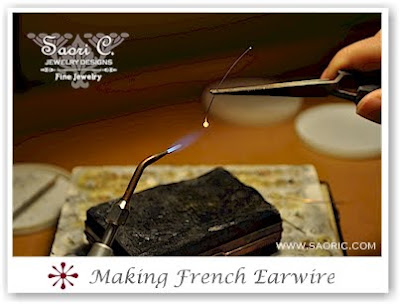Handmade vs. Hand-Assembled: Let’s Talk Ear Wires
What are usually called “French wires” or “French ear wires” are one of the most common accessories to a pair of dangle earrings. They are also almost never made by hand. The vast majority of jewelers will buy these in bulk from a finding manufacturer. Why? Because good ear wires are a hassle to make – expensive and time-consuming. Think about it: you have to cut a piece of wire (silver, gold, whatever) to the correct length, bend the curves in it just so, and then somehow either attach a ring to the end or ball up the metal with a torch so that your dangle won’t slip off. Make a mistake with the torch? Then you either cut off the end and try again, which means the final wire will be shorter than you wanted, or you add the wire to your scrap pile and get another one. Lots of bother.

So why make them by hand? Well, even though it’s a pain, there are a lot of benefits to the customer in a good pair of handmade French wires. The first one is that the size of the wires can be customized exactly to the size of the earrings. If the earring pendant is very small, the last thing you want is a huge ear wire – the back of the wire will hang lower than the earring pendant itself. Same is true conversely – you don’t want a really short wire with a long or heavy earring; it just doesn’t look right, and won’t be comfortable.
Another reason is that making wires by hand allows the jeweler to adjust the stiffness of the wire, most frequently by annealing the metal to the desired strength with a torch after shaping. The ideal wire should be able to flex a bit, but should always spring back exactly into place. If the metal is too hard the wire could snap, if it’s too soft it will easily bend, neither of which are good, and neither of which can be controlled very well with prefab wires.
Next is comfort. Since many pre-made French wires are cut by machine, the end of the wire (the bit you put through your earlobe) can often be rough, or in cases of cheaper wires, even sharp. When making wires by hand, however, the jeweler will take the time to file the tip end of the wire smooth and round, so that there’s no risk of it causing pain when going through the ear.
Now of course, all the extra labor and knowledge that goes into making French wires by hand will tend to increase the cost of the final pair of earrings, and it is the customer’s decision ultimately whether or not it’s worth it. But hopefully now, at least, they’ll know what they’re paying for.
Next time: This series continues as we talk about differences in metal and gem quality and how that affects price. Stay tuned!










